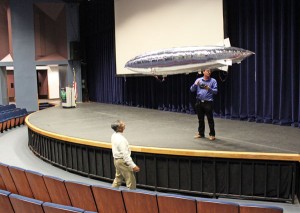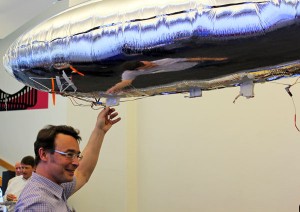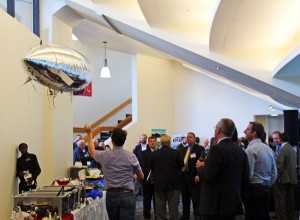Alaska could soon welcome back the era of the dirigible. Researchers argue that helium-powered cargo airships are cheaper and more flexible than conventional air craft — and that could be a game changer for rural Alaskan communities that rely on regular shipments of fuel and supplies. A conference in Anchorage last week drew representatives from around the world to discuss the potential applications of cargo airships in Alaska and how to make those ideas a reality.
A remote controlled model airship is flying around the Wendy Williamson Auditorium at the University of Alaska, Anchorage. And it’s moving pretty fast … for a blimp. German engineer Johannes Eising designed the model and he says that’s because it’s actually a racing blimp.

“In 2004, I sat with friends a bar, and we said, ‘Hey, everyone has these great airship ideas,'” Eising says. “And I said, ‘You know what, just build it and we will have a race.’ This was just thought of as a joke, since airships are anything other than fast. So we had this airship pilot race. It was very good fun. It was in scope of a conference in Germany.”
What everyone’s talking about at this conference – the Cargo Airships for Northern Operations Workshop – feels like science fiction, or maybe a throwback to the 1930s. But it’s not. It’s real, it’s now, and it’s headed for Alaska, according to the workshop’s technical chairman, Ron Hochstetler.
“People think that airships died in the smoldering ruins of the Hindenburg,” Hochstetler says. “But the new technologies of the airships based on the advanced aerospace systems that were developed for airplanes and helicopters are now transitioning into this new expanding, burgeoning cargo airship industry.”
Hochstetler says that airships could transport far more cargo than airplanes to remote locations in the Arctic. And airships don’t rely on expensive airport infrastructure.
“If you can come up with a technology like the airship where the vast majority of investment goes into the vehicle, not into the ground,” he says, “You’ve got a new game.”

Airships are powered mostly by helium, and don’t move as quickly as airplanes, so they don’t require as much fuel. And that makes more economic and environmental sense for remote locations. Hochstetler says Alaska is the best place to get this technology rolling.
“You can go into someplace like the tundra. You can conceivably come into a place where no ones ever landed before and put something heavy down and fly away.”
This is the third year in a row that the Alaska Department of Transportation and NASA’s Ames Research Center have partnered to put on the workshop. Lieutenant Governor Mead Treadwell helped develop the idea in 2010. He says he’s ready to see airships take off in Alaska.
“Everywhere in the state we’ve got places where we’d like to see roads to resources, where you have villages that have to barge in fuel and supplies just once a year, where more immediate heavy lift transportation could not only be better for the environment in some cases but also save costs for our villages.”
Meera Kohler, President and CEO of Alaska Village Electric Cooperative, agrees. She says AVEC serves 55 villages scattered across about 500 thousand square miles. And transportation is their biggest expense. Kohler says AVEC isn’t necessarily about to jump on the airship bandwagon, but they’re always open to new ideas.
“If the technology matures to the point where we feel it’s a viable way forward,” she says, “we’ll do whatever we can to help make that a reality.”

Aviation companies such as Lockheed Martin and AeroVehicles Inc. are starting to make concrete plans to build airships. If all goes smoothly, we could see an airship prototype conducting flight tests in a couple of years, with a Federal Aviation Administration-certified airship starting some commercial operations about three years after that.
But what drives a lot of airship enthusiasts is just the wonder of the thing — how an enormous machine weighing tens or even hundreds of tons can float in the air. Ron Hochstetler says he first fell for the airship when he saw the Goodyear Blimp on display decades ago.
“Suddenly I realized this silent ship is flying all the time. It belongs in the sky,” he says. “It doesn’t have to clamor into the air every time it wants to fly.”
And if the participants at this year’s workshop have anything to say about it, it may be the latest addition to Alaskan skies.




